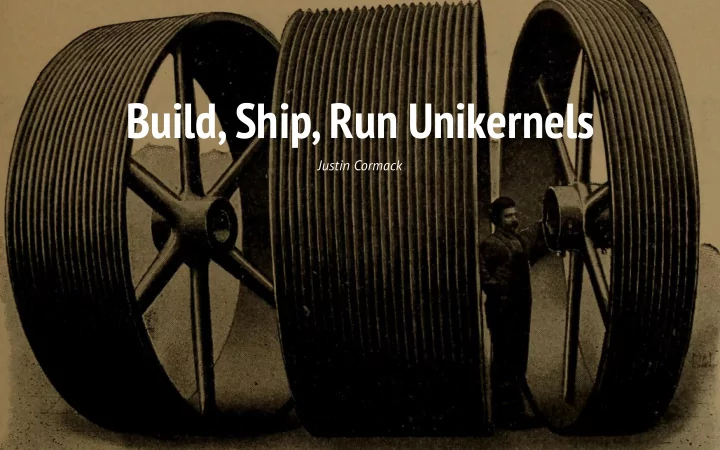

Build, Ship, Run Unikernels Justin Cormack
2 Justin Cormack Cambridge based developer at Docker @justincormack
3 Co-author of Docker in the Trenches: Successful Production Deployment
containers
5
6 • “Linux containers are an operating-system-level virtualization environment for running multiple isolated Linux systems on a single Linux control host” • “Building on top of facilities provided by the Linux kernel, a Docker container, unlike a virtual machine, does not require or include a separate operating system. Instead, it relies on the kernel's functionality and uses resource isolation and separate namespaces to isolate the application's view of the operating system.”
7
8
9
10
11 “Docker containers wrap up a piece of software in a complete filesystem that contains everything it needs to run: code, runtime, system tools, system libraries – anything you can install on a server. This guarantees that it will always run the same, regardless of the environment it is running in.” https://www.docker.com/what-docker
12
13 automation, repeatability, reliability • Repeatable builds • Ship one artifact • Do not depend on the runtime environment • Standard reusable tooling • Build, test, run pipeline with one container shipped through it
unikernels
15 • “Unikernels are specialised, single-address-space machine images constructed by using library operating systems.” • “Unikernels are self contained applications that bundle all their dependencies, and only their dependencies.” • Containers bundle most dependencies, but rely on the kernel the host is running. Unikernels bundle everything.
16
17
18
19 Code you want to run Code your OS includes
20 Currently Linux has over 25 million lines of code... ... and Windows has 50 million.
21 Code you want to run Code your OS includes
22 Unikernels • First cut down on the amount of operating system dependencies lurking under your code. • Just link exactly what you need as libraries, eg tcp, filesystems, etc • Then they can also make that code less scary.
23 A security hardened container • No large OS attack surface • Just what you need, no extra shell or other executables, so small attack surface • Can run inside virtual machine for sandboxing • Language guarantees, like type safety and memory safety • Can use additional sandboxing techniques: ASLR, NaCl etc • Whole system hardening • Ideal for embedded systems
Making systems programming less scary
25
26 • Systems programming is unusually difficult compared to other forms of programming • OS development and design are the pinnacle or programming achievement, and the highest calling for any programmer • Systems programmers are inherently superior to other kinds of programmers • A competent systems programmer will naturally be gifted in all other forms of programming I find these assumptions laughable. – Jay Osako
27 • Systems programming has a huge amount of technical debt • Operating systems are huge, not very modular. • Rebuilding with modern agile development is not as hard as people pretend. • Easier when not working inside a kernel in C.
28 New simpler, more secure stacks in high level languages • Static typing • Memory safety • Use of formal methods • zero-cost abstractions • Test driven development • Fuzz testing
29 Rust • zero-cost abstractions • guaranteed memory safety • threads without data races • type inference • minimal runtime
30 Go • From the Plan 9 operating system heritage • memory safety • strong distributed programming libraries
31 OCaml • Functional language • Full network stack implemented from TCP to SSL • Memory and type safe
32 • Haskell • C++ • LuaJIT • Elixir • JavaScript • Swift
33 Examples of unikernels • Mirage OCaml • IncludeOS C++ • HalVM Haskell • Ling Erlang • runtime.js JavaScript • ClickOS C++ • Rumprun C
how to get there?
35 • hack on some systems code • implement protocols • apply modern tools, processes, languages, methods • have fun
36 • Reduce dependency on OS • Don't shell out to command line • Write portable code • Just ship applications • Do not try to introspect your environment
37 Zvi @nivertech Container with Ubuntu Container with Alpine Linux Linux ABI-compatible fat Unikernel slim Unikernel 1:18 PM - 28 Feb 2016 6 8
Build, Ship, Run
39 Unikernels are still at the stage that Linux containers were three years ago before Docker • Few users • Hard to build • Hard to ship • Hard to run Clearly this needs to be fixed for widespread use...
40 Unikernels are being used in production • Specialist use cases • Classified • Networking devices • Easrly adopters Clearly this needs to be fixed for widespread use...
41 Unikernel.org • Common community to share tooling, code and tests • Working on ways to reuse existing code across languages • Working on standard configuration and other layers • Take the learnings from Mirage and apply more broadly.
42 Integrating unikernels into Docker • Build: Dockerized toolchains • Ship: Artifacts on Docker Hub • Run: Same commands to run unikernels as containers
43 Questions? • @justincormack • justin.cormack@docker.com
Recommend
More recommend